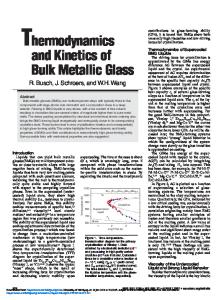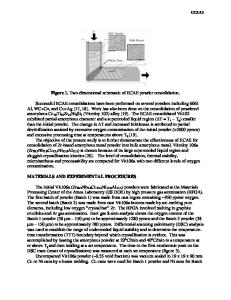Plasma Spheroidization of Vitreloy 106A Bulk Metallic Glass Powder
- PDF / 1,024,304 Bytes
- 7 Pages / 593.972 x 792 pts Page_size
- 10 Downloads / 352 Views
TRODUCTION
BULK metallic glasses (BMGs) are multicomponent metal alloys that are devoid of crystalline microstructure. These glassy alloys are considered ‘bulk’ once fully amorphous microstructure is present in a 1 mm diameter.[1] BMGs are of interest due to their higher strengths compared to their crystalline counter parts, excellent wear and corrosion resistance due to their lack of grain boundaries and dislocations, and high fracture toughness.[2] The unique properties of metallic glasses have attracted interest; however, the need for very high cooling rates limited the exploration of these alloys for many years. Through alloying additions, regions of deep eutectics can be found in multicomponent systems where crystal nucleation can be bypassed and the critical cooling rate can be reduced. One such alloy is Vitreloy 106A, a Zr-based metallic glass where the critical cooling rate is ~ 1.75 K/s.[3] Additive manufacturing (AM) techniques typically use laser or electron beam based consolidation of successive layers of material in order to build a part in a layer-by-layer approach.[4] AM in general has attracted substantial interest in recent years due to the
CAITLIN S. KRIEWALL and JOSEPH W. NEWKIRK are with the Department of Materials Science and Engineering, Missouri University of Science and Technology, Rolla, MO 65409. Contact e-mail: [email protected] Manuscript submitted February 18, 2019.
METALLURGICAL AND MATERIALS TRANSACTIONS A
ability to create near net shaped parts that require little machining and allow design flexibility that is not possible with traditional manufacturing methods. AM has shown promise for manufacturing metallic glass parts due to the inherently high cooling rates associated with the process and the ability to make near net shaped parts. Researchers have had success using AM to processes BMG powder[5] and even foils.[6] Another technique that uses powder feedstock is cold spray (CS) which is used to make coatings. In this process, powder and heated inert gas are pushed through a nozzle directed at a substrate. The high kinetic energy results in the particles getting embedded into the substrate on impact.[7] CS technologies can have cooling rates on the order of 105-106 K/s and therefore researchers have recently starting using metallic glass powders for this process.[8] Both AM and CS use spherical powders, usually in the form of gas-atomized powder. For exotic materials, gas-atomized powder can be extremely difficult to find and expensive. Currently there are only a few places in the United States where amorphous, gasatomized powder can be purchased. There is a need for other methods to attain spherical powder usable in these processes. Plasma processing shows promise for the spheroidization of metallic glass powder because of the several advantages the technology offers. Powders processed through plasma systems have higher flowability, density, and sphericity.[9] The ease of use of commercial plasma systems enables widespread use in academia and industry. Many powders have been spheroi
Data Loading...











